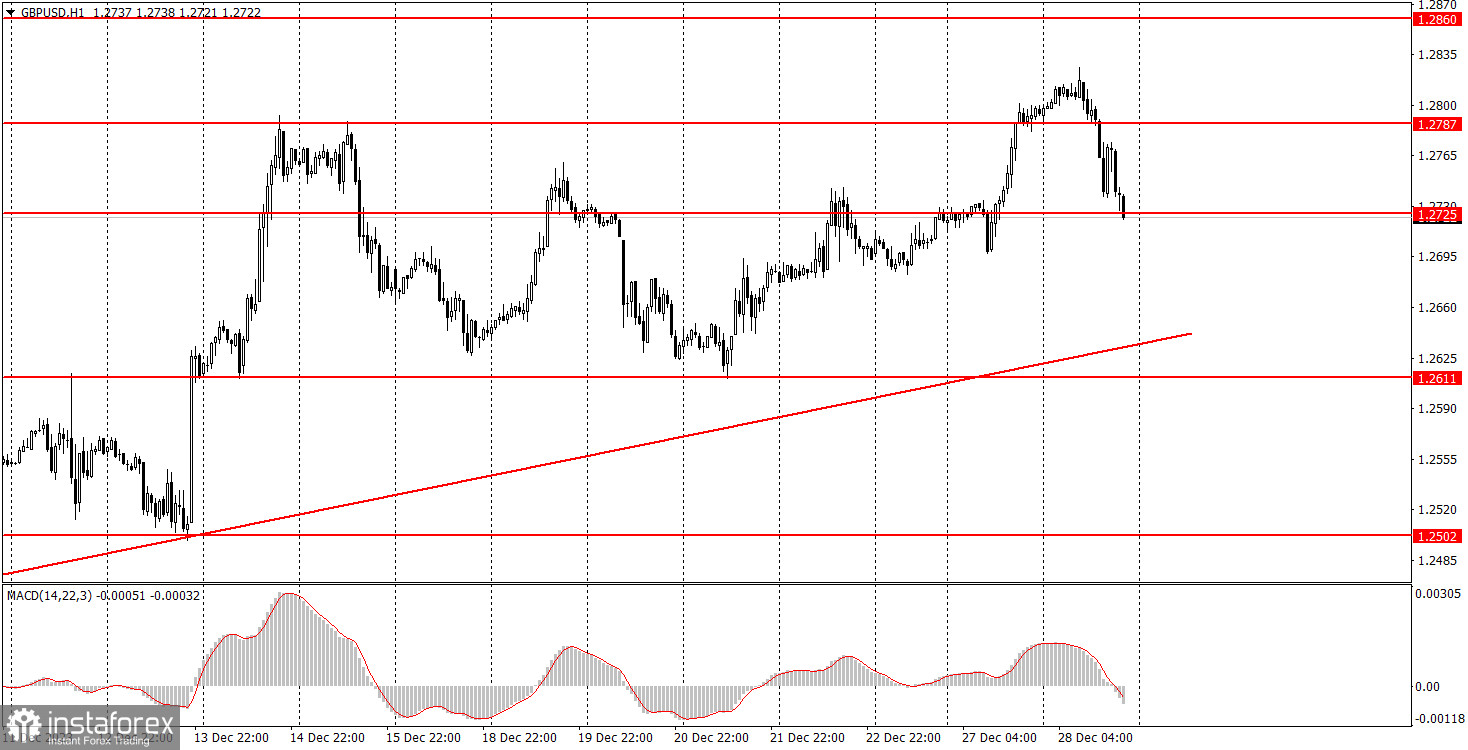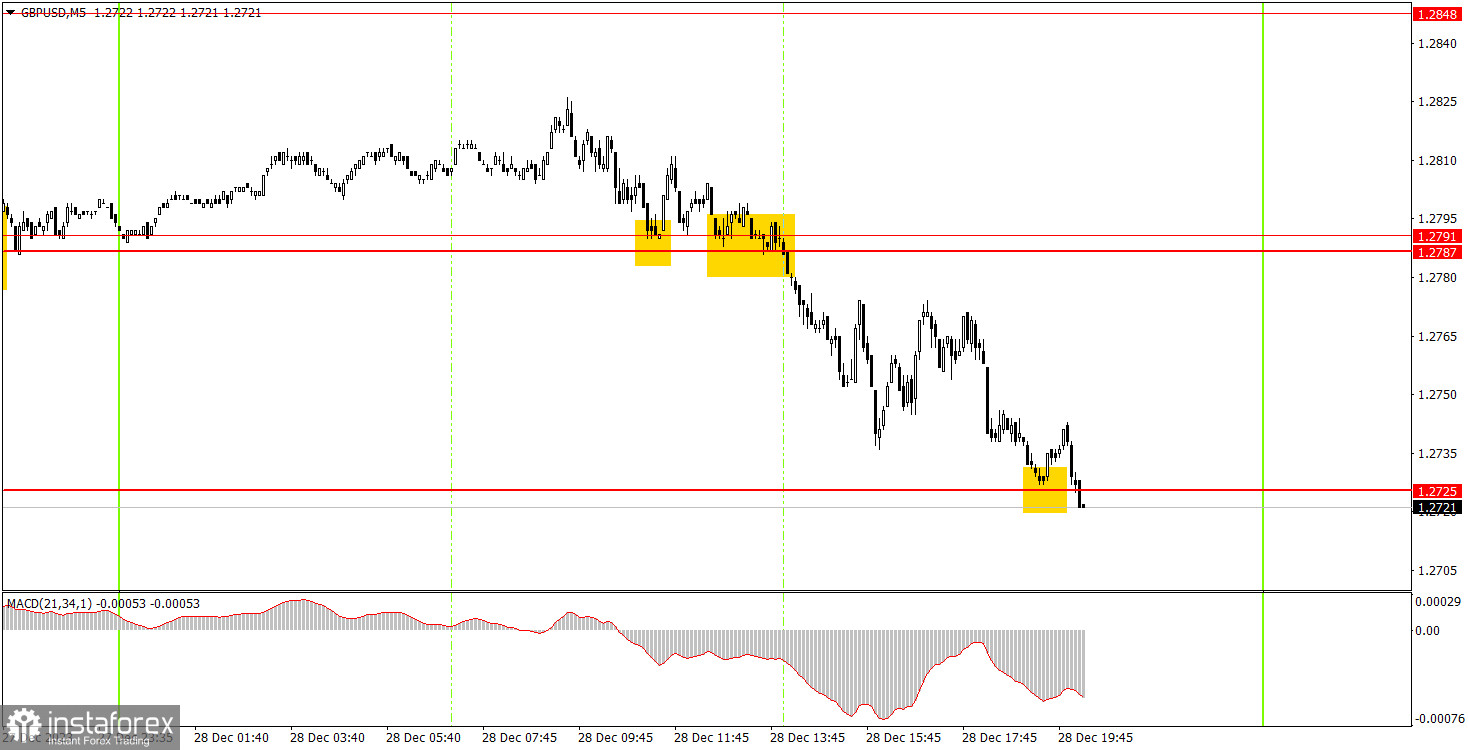Analyzing Thursday's trades:
GBP/USD on 30M chart

GBP/USD showed some bearish bias on Thursday. The British currency lost about 70 pips during the day, but it had risen by 100 pips the day before. The pair did not have any reasons to move in such a way on both days. It would have been more logical for it to stay in a flat range during this holiday week. However, we are witnessing movements that are based on nothing and cannot be predicted.
The uptrend also remains intact. The pound has been rising for three consecutive months, but the entire upward movement is still considered a correction. We see it as a correction until the pair manages to surpass the high established six months ago. We still expect a significant drop in the British currency, but there are currently no signals for it. Such signals will only appear after the price firmly settles below the trendline. For now, the market continues to make unjustified purchases of the British currency. All growth factors have long been priced in. The pound cannot keep rising for half a year or a year based on just one factor, which is the Bank of England's more hawkish stance compared to the Federal Reserve, as we saw in December.
GBP/USD on 5M chart

There were some fairly decent trading signals on the 5-minute chart. The first buy signal around the level of 1.2792 turned out to be a false signal, and the price couldn't move by 20 pips in the intended direction, which would have been enough to set a stop-loss at break-even. However, traders could open short positions using the next signal, and the price subsequently dropped to the level of 1.2725, where they should have taken profit. As a result, the first trade incurred a loss of about 20-25 pips, while the second trade yielded a profit of around 50 pips.
Trading tips on Friday:
On the hourly chart, GBP/USD has resumed and continued its uptrend despite the holidays. The pound continues to trade in an illogical manner, but from a technical analysis perspective, the uptrend remains intact, which means the British currency may continue to rise.
We may see chaotic movements on Friday. Therefore, it will be difficult to find logic behind the pair's movements. However, on the 5-minute chart, you can continue to trade based on the levels, as the current movements are quite trend-oriented and volatile.
The key levels on the 5M chart are 1.2270, 1.2310, 1.2372-1.2387, 1.2457, 1.2502, 1.2544, 1.2605-1.2611, 1.2688, 1.2725, 1.2787-1.2791, 1.2848-1.2860, 1.2913, 1.2981-1.2993. On Friday, the event calendars for the UK and the US are empty. There won't be any important events, but the pound appears ready to move in an active manner even without them.
Basic trading rules:
1) Signal strength is determined by the time taken for its formation (either a bounce or level breach). A shorter formation time indicates a stronger signal.
2) If two or more trades around a certain level are initiated based on false signals, subsequent signals from that level should be disregarded.
3) In a flat market, any currency pair can produce multiple false signals or none at all. In any case, the flat trend is not the best condition for trading.
4) Trading activities are confined between the onset of the European session and mid-way through the U.S. session, after which all open trades should be manually closed.
5) On the 30-minute timeframe, trades based on MACD signals are only advisable amidst substantial volatility and an established trend, confirmed either by a trendline or trend channel.
6) If two levels lie closely together (ranging from 5 to 15 pips apart), they should be considered as a support or resistance zone.
How to read charts:
Support and Resistance price levels can serve as targets when buying or selling. You can place Take Profit levels near them.
Red lines represent channels or trend lines, depicting the current market trend and indicating the preferable trading direction.
The MACD(14,22,3) indicator, encompassing both the histogram and signal line, acts as an auxiliary tool and can also be used as a signal source.
Significant speeches and reports (always noted in the news calendar) can profoundly influence the price dynamics. Hence, trading during their release calls for heightened caution. It may be reasonable to exit the market to prevent abrupt price reversals against the prevailing trend.
Beginners should always remember that not every trade will yield profit. Establishing a clear strategy coupled with sound money management is the cornerstone of sustained trading success.
 English
English 
 Русский
Русский Bahasa Indonesia
Bahasa Indonesia Bahasa Malay
Bahasa Malay ไทย
ไทย Español
Español Deutsch
Deutsch Български
Български Français
Français Tiếng Việt
Tiếng Việt 中文
中文 বাংলা
বাংলা हिन्दी
हिन्दी Čeština
Čeština Українська
Українська Română
Română

